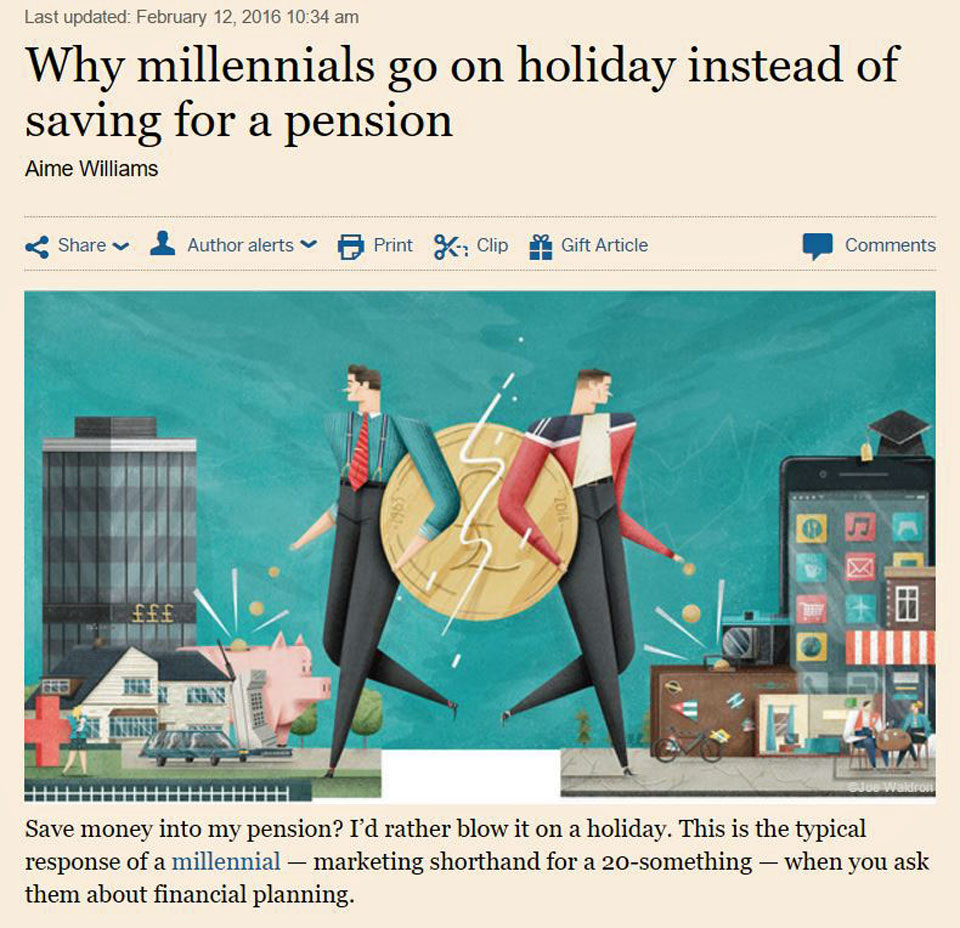What is the true cost of a pension?
and why might it be LESS than 'some' experts tell you?

So what is the true cost of a pension?
It sounds like a simple question doesn’t it?
But it’s seemingly impossible for some financial journalists to get to the bottom of it – as I summarised in this video
So, let’s see how the Press and others might, inadvertently, mislead us about pensions, and if this might be one reason why some people don’t bother to save at all!
This issue affects millions of people
If this article is useful to you or could help a friend or family member, please share it. I honestly believe they’ll thank you for it.
Now, I’ve observed the Pensions and Investment industry (from the inside and out) for more than 30 years now. And what’s clear, is that there are very few people in the media who can help you to navigate it.
Sure, there are lots of journalists who can grab people’s attention with a ‘scary’ headline, or engage them with a good story. And they even have a formula for doing just that.
What makes a strong news story?
Perhaps you’ve noticed, that the stories in the papers (or online or on mainstream TV) normally have one or more of these characteristics:
- They involve some conflict between good and evil. So, in financial stories, you might be told that the bank or insurance company or even the government is the oppressor.
- They have a strong human element. So, you’ll hear about Jenny and Phil and their three ‘lovely children from Weston Super Mare!
- They’re about something Odd or curious. So, “Man bites dog” is more newsworthy than the normal stuff 🙂
The media avoid ‘boring’ stories because they don’t sell papers/produce ‘clicks’/or drive viewer numbers.
What worries me is that their obsession with scary or odd stories is having a very bad effect on the long term wealth of the nation.
And that’s a serious issue because you really need to understand your money to make better decisions about it.
Poor quality or misleading information can cost you tens or hundreds of thousands of pounds over the long term. And my aim with this site is to help you steer a path through all this noise, with solid ideas to help you build your wealth.
So, you might like to contrast this with what you’ll very often see in the papers.
The typical silly pensions story in the press
Below you’ll find just two of the many examples of this story – taken from good quality media outlets – the BBC and the FT.
Obviously, the ‘lesser’ quality newspapers and media outlets get this stuff wrong too; just as often and just as badly – if not more so.
Indeed, in my experience, very few consistently get their facts right or the stories balanced when it comes to pension planning.
So please take their stories with a ‘pinch of salt’.
Shocking is Newsworthy!
Can you imagine seeing this headline?
John Smith saves steadily for years,
and ends up with a decent pension
No, nor can I.
We’re not going to see that one because it’s a useless News headline.
It’s just a boringly good outcome for John!
So, you will not find that story in the press. You’re just left to decipher the facts from the fantasy in their shocking stories.
Examples of silly Pension stories
In March 2016 the BBC ran a story with the headline:
Workers should double their pension savings, says Labour’s review.
And they went on to say, ‘The Independent Review of Retirement Income (IRRI) suggests the target for savings should be 15% of salary – a considerably higher level than has been suggested previously.
Then in July 2017, we got the following headline in the FT to tell us that even YOUNG Britons need to save a phenomenal amount for their pension!
The question is – are they right?
This is news from the BBC and the FT after all 🙂
In short – should everyone save 15% (or 18% or more) of their salary into a pension?
Well, no, of course not.
18% might be just the right amount for a small number of people with particular circumstances. But it’s a useless guide for everyone else.
Some older people, like those who’ve left their retirement savings very late, might need to save a lot more than that. And the alternative for some will be to carry on working – to a ripe old age.
On the other hand, as we’ll see below – a lot of younger people might not need to save nearly as much as that – in order to achieve their financial goals.
So, like most complex questions, the answer to the ‘cost of a pension’ question, depends on your situation – and on the assumptions, you make about the future.
‘One Size’ most certainly does not fit all.
The KEY point on pension (or any kind of money) planning is this
There is no Newspaper or Online Blog in the world that can tell you how much YOU need to save for your own particular goal whether it’s retirement or anything else.
And yes, that includes this blog too.
The only possible exception to this rule is if:
- You subsequently talk to the writer and they’re qualified (and capable) of doing some pension calculations for you. (Clearly, most journalists are not) and
- You’ve supplied them with all your personal objectives and your financial details – and the financial background of your wider family too – as that could also be relevant.
Unless you do that then no one can work out your numbers for you.
Now, I assume that you don’t share your personal financial details with Journalists or bloggers?
The press do NOT have the answers
So, please let’s stop pretending that the press have the answers to this thorny question.
Personal financial life planning is… well, it’s personal, as we saw here
Although if you have a group of people (employees or friends) and would like them to learn how to work these numbers out for themselves, I might be able to help with some education around a planning process.
Contact me here for help with that, or sign up to my newsletter for updates and more ideas
Now for the silliest story, I’ve seen on pensions
So, this one actually appeared in one of my preferred papers (the Financial Times) a while ago – on 12 February 2016.
The article went on to say:
“Today’s 25-year-olds need to save the equivalent of £800 a month over the next 40 years to retire at 65 with an income of £30,000 a year . . .”
Now, in case that’s shocked you, like it did me, let’s read it again and spell out the key points:
- Today’s 25-year-olds
- Need to save
- Eight hundred pounds
- Per month
- Every month
- For a 40-year working life
- To get a pension of £30k p.a.
Wow! Really?
When I saw that I wondered, ‘What planet are the FT living on?’
But then I remembered that the FT, like any other paper, feels it has to run some shock-horror stories.
And, from their perspective, they were successful too.
That article went ‘viral’ which is a rare event for an FT article – especially one on pensions.
That said, it’s not surprising that it went ‘viral’ with that shocking c. £10,000 p.a. cost guidance, is it?
What astonished me was that to build on their “success”, the FT ran another story (the following week) congratulating themselves on the interest they’d generated with this ‘shock’ story.
And in that follow up they showed some of their funniest Twitter reactions.
This was my favourite
Funny, don’t you think 🙂
Well, yes, it is funny but it’s also very sad because it proves how these ‘shocking’ pension articles put people off doing the right thing – and saving for their later years.
So what’s to be done about this?
Well, I offered the FT my services at the time – to write a more balanced article on the true cost of a pension – but as of today… I’m still waiting to hear back on that. So, in the meantime
Here’s what a 25-year-old should know about pension costs
Your starting personal net cost to fund that modest pension could be as low as:
- £229 per month
- That’s £7.52 per day*
What’s more, if you’re employed (as compared to being self-employed) and your employer matches your contribution to a pension, then your starting cost would be halved.
So, that’s as little as £114 per month (net) in my example* – or more than 85% less than the FT’s £800 headline.
Or, to put that another way, just £3.76 per day – or about the same as one nice coffee a day!
* Really, less than £4 per day?
Well, bear in mind that the government will (normally) add tax relief to your personal input to pensions – and this £3.76 a day example assumes your employer matches your input. I’ve also made some reasonably optimistic assumptions.
Your estimate of what you need to save – for the long term – depends heavily on the assumptions you use to work out your numbers.
And the longer the term (40 years in this example) the more the results are affected by small tweaks in these assumptions.
Here’s how your ‘estimated costs’ could vary – if we tweak these numbers. For example:
- If you used more conservative assumptions for your investment returns (down from 4.6% p.a. to 2.6% p.a. ‘real’) then you might estimate your starting personal net cost (to fund that same pension) to be nearer £6 per day.
- Be more conservative about future yields on government bonds (the investments that drive rates on pension annuities – which many use to convert their pension fund to income in retirement) and that figure might rise to about £7.50 a day.
- Assume that you’ll build in two layers of inflation protection- both: a) Up to retirement, as we’ve done here and b) during retirement… and your number could rise to c. £12 per day. That said, you might want to bear in mind that a ‘Gold-Plated’ pension with inflation protection during retirement is very expensive and very few people outside of defined benefit pension schemes can afford them. So you might want to consider funding that extra option once you’ve got started on your plan and if you can afford to do so. And that decision can wait until you’re a lot older than 25!
To learn more about my assumptions – see further down this page.
Also, do you really need £30,000 p.a.?
What if that amount looks unaffordable, even on my optimistic assumptions.
Well, perhaps you could target a pension of £20,000 p.a. for now, instead.
Do that and your personal (net) starting savings cost might be as little as £64 per month (£2.10 per day)... provided that you’re happy with optimistic assumptions – and your employer pays half.
And that’s a much cheerier headline – don’t you think?
In defence of the journalists
Now, you might wonder why journalists publish stories so often – about how pensions are absurdly unaffordable?
They certainly do like a good ‘shocking’ story, but it’s not just for that reason.
You see, the journalists get their numbers from cautious financial advisers and other ‘experts’, and it’s these experts who (in some ways, understandably) are fearful of getting into trouble with their financial regulator – if they’re thought to be:
- Too optimistic about investment returns or
- They assume that pension savers will buy a fixed pension income (vs inflation proofed one) with their funds – despite the fact that ‘fixed’ incomes are precisely what most people buy.
So, financial advisers tend to assume that everyone saving for a pension is going to want a Rolls Royce version, and they forget the fact that most people can’t afford that kind of car!
The bottom lines
The true cost of a modest pension (for YOU personally – and on top of the state pension) may be higher or lower than the example numbers we’ve looked at here.
However, the essential point to learn here is that building a modest pension (if you start when you’re young) is NOT an impossible dream. It’s actually quite achievable for most.
The challenge gets bigger – and much, much bigger – if you reach your 40s and 50s without any savings.
People in that situation can easily be tempted to take big risks with their money – in an attempt to catch up with those taking the gentle savings approach.
Note the climbers in this image whose risky late climb plan might work – but only if they’re lucky!
Remember that whatever your situation, the amount you need to save – to hit your target pension income, years from now, will vary a great deal on the assumptions you make.
There are lots of variable factors to take into account – when planning your pension. And we’ll explore these in detail another time.
For now, if you look at the assumptions I’ve used – to lower the estimated cost – you’ll start to see why the estimates you’ll get (from advisers or online systems) can vary so much.
Assumptions I’ve used to estimate pension cost
- The target pension includes a full state pension of £9,110 p.a. (I assume that the state pension was ignored by the FT)
- The gap in state pension income (between age 65 and state retirement age, currently estimated to be age 68) is also funded in this estimate.
- The pension saver, and their employer where applicable, increase their pension contributions each year, in line with inflation.
- Real, after inflation, investment returns on the pension fund are c. 4.5% p.a. after charges of 0.4% p.a. These investment returns are the same (or somewhat less) than the very long-term average returns from the UK (or US) stock markets. How you choose to invest – for the very long term – should largely be a function of your attitude to risk and your capacity to take it – which is high in this scenario. Actual investment returns could, of course, be higher or very possibly lower than this. And, just as importantly, the returns experienced by the pension saver will depend on how the fund price moves over time (a complex concept we’ll cover another time) If you prefer to use a lower assumed investment return, of say, 2.6% p.a. after charges, you’d need to add c.60% to my estimated savings costs.
- The pension fund is converted to an annual income at the rate of c.7.3% p.a. This assumes a medium-term gilt yield (MTGY) of 5% in 40 years’ time. No one knows what these yields will be, but 5% is as good a guess as any other given historical rates. It’s also a reasonable assumption if the UK is meeting its target inflation rate and gilts are delivering their historic average real returns. Actual MTGYs have varied enormously over the past 50 years but averaged c. 6% over the 20 years prior to the global financial crisis in 2009 when emergency-low interest rates were introduced. If you prefer to assume a lower future gilt yield, say 3%, add 20% to my estimated costs.
- The annuity is a basic fixed annuity – the same as most people choose today because inflation-linked annuities are prohibitively expensive. Therefore, inflation would erode the real value of the private (non-state) pension element of income over time. This is a fact of life for most Defined Contribution pension savers. If you can save more in later life to provide some inflation protection in retirement, that’s something to consider.
Long term financial life planning is not an exact science
No one has any idea what investments will return, or where gilt yields (for annuity pricing – if that’s your chosen income vehicle) will be – in forty years from now.
However, it’s fair to expect that a 25-year-old pension saver (receiving ‘matched – or near matched’ contributions from their employers) could build a reasonable starting income at age 65 – even if they use modestly optimistic assumptions in their planning.
And what’s certain is that they’ll have no pension income at all – if they use ultra-conservative assumptions – that put them off saving altogether… and they take a lot more holidays instead.
You need to steer clear of the nonsense that’s written about pensions. And, sadly, there’s plenty of that out there.
So please be very selective about what you read… and who you follow.
Stick around here – and you won’t go wrong.
Thanks for dropping in
Paul
For more ideas to achieve more in your life and make more of your money, sign up to my newsletter
As a thank you, I’ll send you my ‘5 Steps for planning your Financial Freedom’ and the first chapter of my book, ‘Who misleads you about money?’

Also, for more frequent ideas – and more interaction – you can join my Facebook group here
Share your comments here
You can comment as a guest (just tick that box) or log in with your social media or DISQUS account.







Discuss this article